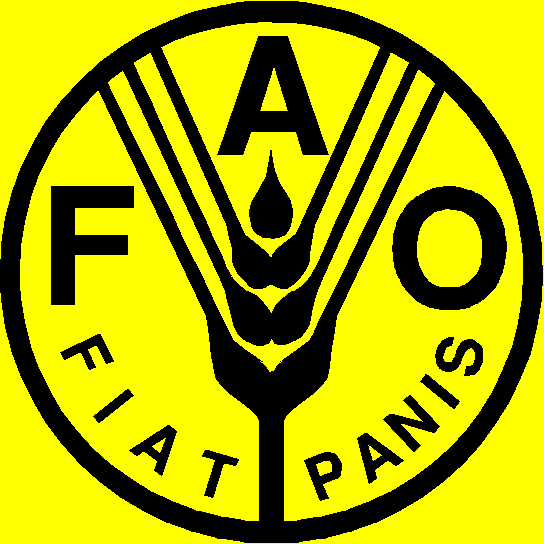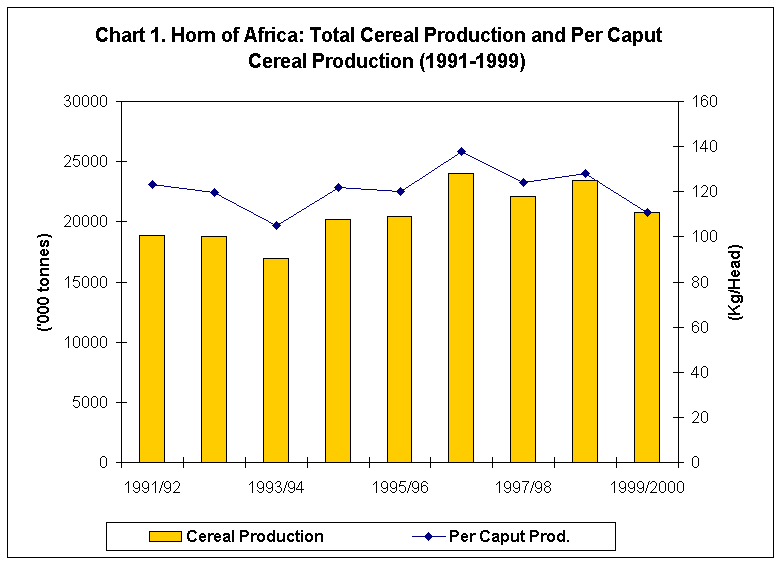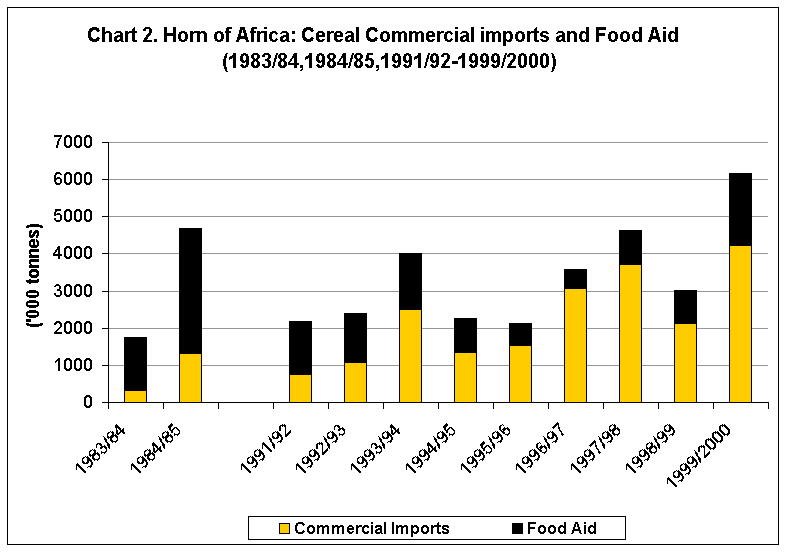
| UNIVERSITY OF PENNSYLVANIA - AFRICAN STUDIES CENTER |
No. 306
(Circulated only for countries where foodcrops or supply situation conditions give rise to concern)
Date: 18 April 2000
A HUMAN CATASTROPHE LOOMS IN THE HORN OF AFRICA
Djibouti, Eritrea and parts of Sudan are also experiencing food supply difficulties due to adverse weather and insecurity in parts. Large numbers of people from Sudan are moving to neighbouring countries in search of food and water.
Over the past decade, the sub-region's total cereal production that increased gradually during 1991-1996 has since been declining due mainly to adverse weather. Similarly, the per caput cereal production saw little variations and was declining since 1996 (Chart 1). Consequently, to meet consumption needs, the sub-region's total cereal imports were growing, albeit with some fluctuations, and in 1999/2000 the forecast cereal import requirement stands at a record of over 6 million tonnes, almost double the actual import level of 1998/99 and more than 30 percent above 1984/85, a major drought and famine year (Chart 2).
In response to the early warnings issued by FAO's Global Information and Early Warning System, and the joint FAO/WFP assessments, several Emergency Operations (EMOPs) worth some US$ 880 million were jointly approved by FAO and WFP from 1998 up to March 2000 for food assistance to the drought and war/civil strife affected population in the sub-region. However, the food aid requirements for 2000 have risen sharply and are currently estimated at about 2 million tonnes, more than double last year's volume and the highest level for the past 15 years. With grim prospects for the current agricultural season and low foreign exchange earnings in some of these countries due to low world prices of export commodities such as coffee, food aid requirements are anticipated to increase further. Food aid pledges by the international community are just gathering momentum, particularly following the UN envoy's visit to the region, but speedier delivery and more pledges are required to avoid further human suffering and loss of life.

FOOD AND AGRICULTURE ORGANIZATION OF THE UNITED NATIONS, ROME
In view of the recurring nature of the drought and food crisis in the Horn of Africa, there is pressing need to address the long term food security and agricultural development issues. Accordingly, a UN Task Force, led by FAO, is developing a comprehensive strategy to mitigate the effects of recurrent drought and to achieve lasting food security in the region.


With bleak prospects for the 2000 secondary "Belg" crop, to be harvested from May, the number of people in need of food assistance could increase to more than 9 million. The Belg crop accounts for around 8 to 10 percent of annual cereal and pulse production but in some northern parts it provides a major part of annual grain production. The failure of last year's Belg season and persistent drought through the 1999 main "Meher" season severely affected the food security of a large number of people.
Cereal import requirements in 2000 estimated by FAO and WFP at 764 000 tonnes in January are likely to substantially increase following the poor belg season rains so far.
Harvesting of the 1999/2000 secondary "Deyr" cereal crop, normally accounting for some 25 percent of annual cereal production, is complete, while planting of the 2000/01 main season crops is about to start. Total cereal production from the 1999/2000 Deyr season is estimated at 108 000 tonnes, 53 percent above the post-war (1993-1998) average. However, the output of the main 1999 "Gu" season cereal crops, harvested until last September, was estimated by an FAO/WFP Mission at 135 683 tonnes, about 32 percent below the post-war average due to poor rains, pests and displacement of farmers.
Food aid deliveries continue to be hindered by insecurity.
Prices of maize, the key staple of the country, have increased sharply in most parts affecting access to food for a large number of people. Recent reports indicate that a the country will need to import about 2.5 million tonnes of maize in the year 2000. In January 2000, an Emergency Operation worth US$ 43.4 million was jointly approved by FAO and WFP to assist 2.74 million drought affected people for a period of five months. In February, the Government appealed for about US$62 million to cope with the looming food shortage and has distributed some 57 000 tonnes of maize to the affected population in the last eight months.
Planting of the 2000 cereal crops will start in June. The 1999 cereal and pulse output was poor due to drought and delayed sowing. The drought in the coastal areas was particularly severe, affecting crops and pasture. In addition, in areas affected by armed conflict with neighbouring Ethiopia, production was seriously affected by population displacement.
A severe drought since last May has put more than 100 000 people, one-sixth of the country's population, at risk of starvation. Emergency food aid is being distributed to the affected population.
Lower harvests of sorghum and millet in 1999 and the depletion of stocks, mainly due to a surge in exports, have led to an increase in cereal prices which will have an adverse effect on poorer segments of the population. Overall, with the estimated cereal production and imports of wheat and rice estimated at 680 000 tonnes and 38 000 tonnes respectively, the country's cereal requirement of about 5.2 million tonnes in 1999/2000 is expected to be met by a draw-down of stocks of nearly 240 000 tonnes.
Earlier in the year, the total food aid requirement in 2000 was estimated at 103 453 tonnes for the various interventions in southern Sudan and food deficit regions in the northern states. However, food supply difficulties are emerging in parts of the country due to both drought and security problems, which are causing the movement of large numbers of people to neighbouring countries.
In January 2000 an Emergency Operation worth US$ 58.14 million was jointly approved by FAO and WFP for food assistance to 2.4 million people affected by war, drought and floods, for a period of 12 months.
The 1999/2000 cereal crop, mainly maize, is estimated at 4 million tonnes, about 8 percent below last year's output due to erratic rains, reduced use of inputs and an outbreak of armyworms. By contrast, production of other food crops, including beans, potatoes, cassava and plantains increased by nearly 13 percent.
Overall, despite lower cereal production in 1999/2000, the food supply situation is stable reflecting large maize imports in the second half of 1999 and a maize export ban imposed by the Government. In January 2000, maize prices in several markets of the country were up to 56 percent lower than at the same period a year earlier and bean prices were up to 41 percent lower. However, food assistance is required for nearly 800 000 people identified as food insecure, mainly in the regions of Dodoma, Mara, Shinyanga, Singida, Tabora, Tanga and southern Mwanza, all of which have suffered their third consecutive poor harvest. WFP started a school-feeding programme in January in 128 primary schools in Dodoma region and is expected to expand to Arusha and Singida regions.
The main season harvest in 1999 was below average due to a prolonged drought experienced in various parts of the country. Cereal production in 1999 is estimated at 1.7 million tonnes, about 9 percent below average.
The food supply situation is satisfactory in most parts of the country. Prices of maize and beans in January and February were below the last three years' average. Nevertheless, the food supply situation has deteriorated in Kotido and Moroto districts, due to a poor harvest and loss of cattle to raids, with nearly 215 000 people needing urgent food assistance. Furthermore, food assistance continues to be needed for nearly 112 000 people in Bundibugyo District displaced by civil strife.
| This report is prepared on the responsibility of the
FAO Secretariat with information from official and unofficial sources.
Since conditions may change rapidly, please contact Mr. Abdur Rashid, Chief,
ESCG, FAO, (Fax: 0039-06-5705-4495, E-Mail (INTERNET): GIEWS1@FAO.ORG)
for further information if required.
Please note that this Special Report is available on the Internet as part of the FAO World Wide Web at the following URL address: http://www.fao.org/giews/ . The Special Alerts/Reports can also be received automatically by E-mail as soon as these are published, subscribing to the GIEWS/Alerts report ListServ. To do so, please send an E-mail to the FAO-Mail-Server at the following address: mailserv@mailserv.fao.org, leaving the subject blank, with the following message: |